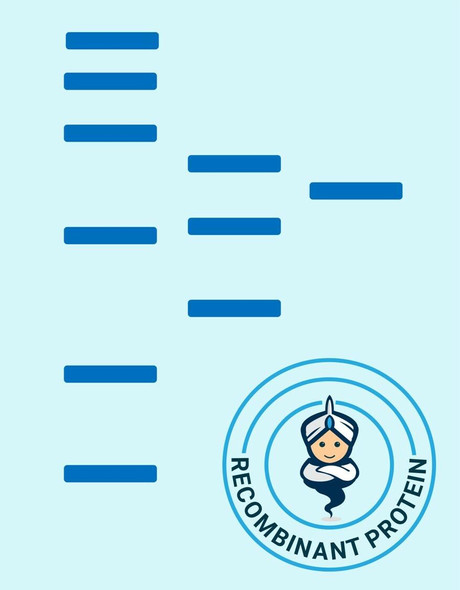Human RAD1 Recombinant Protein (RPPB4382)
- SKU:
- RPPB4382
- Product type:
- Recombinant Protein
- Size:
- 10ug
- Species:
- Human
- Target:
- RAD1
- Synonyms:
- RAD-1
- HRAD1
- REC1
- Cell cycle checkpoint protein RAD1
- Source:
- Escherichia Coli
- Uniprot:
- O60671
Description
| Product Name: | Human RAD1 Recombinant Protein |
| Product Code: | RPPB4382 |
| Size: | 10µg |
| Species: | Human |
| Target: | RAD1 |
| Synonyms: | RAD-1, HRAD1, REC1, Cell cycle checkpoint protein RAD1, hRAD1, EC=3.1.11.2, DNA repair exonuclease rad1 homolog, Rad1-like DNA damage checkpoint protein. |
| Source: | Escherichia Coli |
| Physical Appearance: | Sterile filtered colorless solution. |
| Formulation: | RAD1 Human solution containing 20mM Tris pH-8, 1mM DTT, 0.2M NaCl & 10% glycerol. |
| Stability: | Store at 4°C if entire vial will be used within 2-4 weeks. Store, frozen at -20°C for longer periods of time. For long term storage it is recommended to add a carrier protein (0.1% HSA or BSA). Avoid multiple freeze-thaw cycles. |
| Purity: | Greater than 90.0% as determined by SDS-PAGE. |
| Amino Acid Sequence: | MGSSHHHHHH SSGLVPRGSH MPLLTQQIQD EDDQYSLVAS LDNVRNLSTI LKAIHFREHA TCFATKNGIK VTVENAKCVQ ANAFIQAGIF QEFKVQEESV TFRINLTVLL DCLSIFGSSP MPGTLTALRM CYQGYGYPLM LFLEEGGVVT VCKINTQEPE ETLDFDFCST NVINKIILQSEGLREAFSEL DMTSEVLQIT MSPDKPYFRL STFGNAGSSH LDYPKDSDLM EAFHCNQTQV NRYKISLLKP STKALVLSCK VSIRTDNRGF LSLQYMIRNE DGQICFVEYY CCPDEEVPES ES |
RAD1 is part of a heterotrimeric cell cycle checkpoint complex, recognized as the 9-1-1 complex, that is activated to stop cell cycle progression in reaction to DNA damage or incomplete DNA replication. RAD1 complex withholds the Rad9 and Hus1 proteins and takes part in cellular responses to DNA damage, by associating with Rad17 and several components of the PCNA-loading heteropentamer, replication factor C. RAD1 takes part in DNA repair and recruited to DNA lesion upon damage by the RAD17-replication factor C (RFC) clamp loader complex. RAD1 takes part as a sliding clamp platform on DNA for several proteins that play a role in long-patch base excision repair (LP-BER). RAD1 complex stimulates DNA polymerase beta (POLB) activity by raising its affinity for the 3''-OH end of the primer-template and stabilizes POLB to those sites where LP-BER proceeds.
RAD1 Recombinant Human produced in E.Coli is a single, non-glycosylated polypeptide chain containing 301 amino acids (1-282 a.a.) and having a molecular mass of 33.9 kDa. The RAD1 is fused to 20 amino acid His-Tag at N-terminus and purified by proprietary chromatographic techniques.
| UniProt Protein Function: | RAD1: Component of the 9-1-1 cell-cycle checkpoint response complex that plays a major role in DNA repair. The 9-1-1 complex is recruited to DNA lesion upon damage by the RAD17-replication factor C (RFC) clamp loader complex. Acts then as a sliding clamp platform on DNA for several proteins involved in long-patch base excision repair (LP-BER). The 9-1-1 complex stimulates DNA polymerase beta (POLB) activity by increasing its affinity for the 3'-OH end of the primer-template and stabilizes POLB to those sites where LP-BER proceeds; endonuclease FEN1 cleavage activity on substrates with double, nick, or gap flaps of distinct sequences and lengths; and DNA ligase I (LIG1) on long-patch base excision repair substrates. The 9-1-1 complex is necessary for the recruitment of RHNO1 to sites of double-stranded breaks (DSB) occurring during the S phase. Isoform 1 possesses 3'->5' double stranded DNA exonuclease activity. Belongs to the rad1 family. 3 isoforms of the human protein are produced by alternative splicing. |
| UniProt Protein Details: | Protein type:Cell cycle regulation; DNA repair, damage; Deoxyribonuclease; EC 3.1.11.2 Chromosomal Location of Human Ortholog: 5p13.2 Cellular Component: nucleoplasm; intracellular membrane-bound organelle; chromosome; nucleus Molecular Function:protein binding; exodeoxyribonuclease III activity; damaged DNA binding; 3'-5' exonuclease activity Biological Process: meiotic recombination checkpoint; substantia nigra development; DNA damage checkpoint; DNA repair; DNA catabolic process, exonucleolytic; DNA replication; response to DNA damage stimulus |
| NCBI Summary: | This gene encodes a component of a heterotrimeric cell cycle checkpoint complex, known as the 9-1-1 complex, that is activated to stop cell cycle progression in response to DNA damage or incomplete DNA replication. The 9-1-1 complex is recruited by RAD17 to affected sites where it may attract specialized DNA polymerases and other DNA repair effectors. Alternatively spliced transcript variants of this gene have been described. [provided by RefSeq, Jan 2009] |
| UniProt Code: | O60671 |
| NCBI GenInfo Identifier: | 74735450 |
| NCBI Gene ID: | 5810 |
| NCBI Accession: | O60671.1 |
| UniProt Secondary Accession: | O60671,O75572, O95304, Q1W161, Q5KSM0, Q5KSM1, Q9UEP1 |
| UniProt Related Accession: | O60671 |
| Molecular Weight: | 31,827 Da |
| NCBI Full Name: | Cell cycle checkpoint protein RAD1 |
| NCBI Synonym Full Names: | RAD1 checkpoint DNA exonuclease |
| NCBI Official Symbol: | RAD1 |
| NCBI Official Synonym Symbols: | REC1; HRAD1 |
| NCBI Protein Information: | cell cycle checkpoint protein RAD1; RAD1 homolog; exonuclease homolog RAD1; DNA repair exonuclease REC1; checkpoint control protein HRAD1; DNA repair exonuclease rad1 homolog; cell cycle checkpoint protein Hrad1; rad1-like DNA damage checkpoint protein |
| UniProt Protein Name: | Cell cycle checkpoint protein RAD1 |
| UniProt Synonym Protein Names: | DNA repair exonuclease rad1 homolog; Rad1-like DNA damage checkpoint protein |
| Protein Family: | DNA repair protein |
| UniProt Gene Name: | RAD1 |
| UniProt Entry Name: | RAD1_HUMAN |





